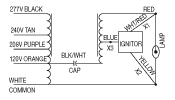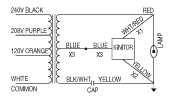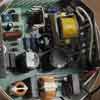| |
Single Voltage Hybrid and HX
ballasts
The
Single Voltage Hybrid and HX family of ballasts includes single voltage lag and multi-tap HX
circuit designs and incorporates ignitors. They are carefully matched
to Uni-Form pulse start lamps to provide peak lamp performance.
Single voltage designs offer the most overall value to the end user.
Multi-Tap; and CWA designs offer flexibility and lower inventories
for distributors, OEMs, and contractors. Venture also offers a full
line of multi-tap CWA ballasts for Uni-Form pulse start lamps where
CWA ballasts have been specified.

Single Voltage Hybrid 277V
These
are optimized lag/reactor ballasts. The flux density, losses and
power factor capacitor are chosen for good circuit loading and modest
lamp power variation with respect to lamp voltage variation. These
ballasts provide more consistent color from lamp-to-lamp than constant
current designs. The circuit loading (250W — 875W) is similar
to that of CWA ballasts, providing better value and performance
without the need for higher capacity circuits.

High Reactance
Autotransformer (HX-HPF)
These
are two coil ballasts, consisting of a primary winding that provides
the voltage transformation for OCV requirements, coupled with a
secondary coil for limiting current. The ballast uses more material
and has higher losses than its lag/reactor counterpart. In return,
it offers multi-tap capability to serve a wide variety of applications.
A capacitor is typically connected to the highest voltage tap to
increase input power factor. Lamp performance is excellent.

HX Multi-Tap
Our
multi-tap ballasts are HX circuits that have the same lamp power
regulation characteristic as 277V Single
Voltage Hybrid ballasts. They are
multiple tap HX autotransformers with all of the common US input voltages.
The flux density, losses and power factor capacitor are chosen for
good circuit loading. They generate modest lamp power variations,
with respect to lamp voltage variations. As a result, these ballasts
provide more consistent color from lamp-to-lamp than CWA. Multi-tap
ballasts can be used in a wider range of applications than 277V
Single Voltage Hybrid ballasts, while providing the same performance benefits.
Circuit loading is similar to comparable CWA ballasts.
back
to top
|
|
Constant
Wattage Autotransformer (CWA)
Present day CWA
ballasts for metal halide lamps have changed very little from early
designs dating back to the 1960’s. Versions with ignitors to
operate pulse start lamps are available, along with a wide range
of wattages. CWA ballasts have a large installed base in the US.
Note that low wattage metal halide lamp performance with CWA ballasts
has proven to be poor. Most ballasts sold for lamps of 150 watts
or less are either lag or HX types.

CWA ballasts
have two coils. One acts as an autotransformer with multiple input
taps and a second provides inductance that in series with a capacitor
controls lamp current. For standard probe start designs, the
capacitor usually connects between the lamp and the secondary coil
of the ballast. In pulse start designs, the capacitor usually connects
between the primary and secondary coils. A tap near the lamp output
on the secondary coil is connected to the ignitor circuit.

"Constant
wattage" is actually a misnomer. The circuit provides more
or less constant current to the lamp. This is undesirable for lamp
loads that do not provide constant voltage. HPS lamps are unstable
when they are operated at constant current. CWA circuits have been
modified for HPS lamps, but use more materials and result in higher
losses. This is also an issue for metal halide lamps that rise in
voltage with aging. The result is lamp-to-lamp power variation that
shows up as lamp-to-lamp color variation. As long as demand for
CWA ballasts continues, Venture will provide them with the best
technology available.
Constant
Wattage Isolated Transformer (CWI)
CWI
ballasts share the same features as the CWA versions, but have electrically
isolated secondary coils to meet the Canadian Electrical Code. These
ballasts use slightly more material than CWA types, making them
less energy efficient and more costly.

back
to top
|
|
Magnetically
Regulated Ballasts (a.k.a. Regulated Lag)
Magnetically
regulated ballasts use three coils and saturable magnetic elements
to provide a high degree of power regulation to the lamp. From the
perspective of the lamp, operation is the same as on a lag ballast
with a well-regulated input voltage. These typically have twice
the material content of comparable CWA ballasts and higher losses.
They are primarily used in heavy industrial settings where switching
of large electrical loads impacts lighting circuits (for example,
a downlight hanging from a crane in a steel mill). Venture currently
does not offer these because demand is small.
Electronic
Ballasts
Fluorescent
lighting now uses electronic ballasts for essentially all new commercial
lighting in the US, largely because of energy legislation. Fluorescent
lamps generate more lumens per watt when operated at high frequency
and have no compatibility issues. HID lamps have two issues. There
is no demonstrable LPW improvement at high frequency and they exhibit
acoustic resonances that disturb lamp operation at the frequencies
used for fluorescent lamps. As a result, the adoption of electronic
HID ballasts has been slow.

The most mature
metal halide electronic ballasts operate low wattage (150 watts
and less) metal halide lamps. The lower the lamp wattage, the higher
the resonant frequency. Designers have opted for low frequency circuits
that drive low wattage lamps with square wave current. The small
size and light weight of low watt electronic ballasts fit retail
track lighting applications very well. High wattage lamps have lower
resonant frequencies, so ballast designs that operate lamps in the
100 KHz range and above work quite well. These ballasts have low
losses, control/program lamp power, and are small and light. Dimming,
in conjunction with the use of natural daylight, is a workable strategy
with a shorter payback period.
Venture is investigating
a number of exciting performance phenomena. Some lamps operating
on electronic ballasts (HF, DC, or square wave) provide higher maintained
lumens over life. This is a rapidly evolving topic. Look to our
website for new developments.
Ballasts
that Venture sells in North America include the following versions:
• Quad-tap:
120V, 208V, 240V and 277V
• Tri-tap:
120V, 277V, 347V
• 480V/120T:
A 480V ballast with a 120V tap for standby quartz lighting.
• 600V
(Canada)
• Most
Lag and HX ballasts are rated for supply voltage variations of ±5%.
• CWA
and magnetically regulated circuits are rated for supply voltage
variations of ±10%.
back
to top
|
|

